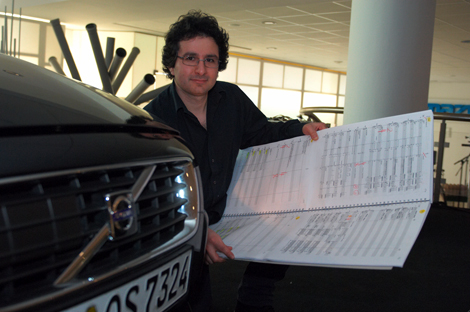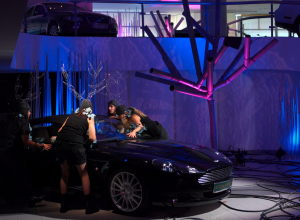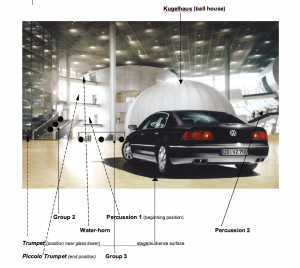
Composer Marios Joannou Elia. All images by Martin Sigmund, Staatsoper Stuttgart.
The young Cypriot composer Marios Joannou Elia talks about his compositions for unusual performance spaces, the challenges of working outside of the opera house and concert hall, and his upcoming projects. Elia, who has studied at the Mozarteum in Salzburg, is the recipient of the Witold Lutoslawski Award and the Kazimierz Serocki Prize in Warsaw, the Edison Denisov Prize in Moscow and the BMW Patronize Award of the Musica Viva in Munich. He received numerous commissions and his music has been performed in prestigious performance venues such as the Staatsoper Stuttgart, the Berliner Philharmonie, as well as the Staatsoper Hannover.
Matthias Röder: Marios, in some of your recent works you have focused on bringing music to non-traditional performance spaces. What is your aim in doing so? Can you give us some specific examples of how the choice of venue affects your compositions?
Listen to
Marios Joannou Elia: Akanthai – für Kammerochester (2006)
Ensemble Modern, Conductor: Stefan Asbury / Hsian-Lin Liao
Marios Joannou Elia: I will answer your question beginning with an example: My latest opera project “Die Jagd” was performed in the main exhibition hall of one of the biggest car dealers in Germany, the Schwabengarage in Stuttgart. On the one hand the Schwabengarage offered us the possibility of using their space, where cars can be positioned, and sponsoring at the same time six luxury cars that were used extensively as musical material in my composition. Furthermore the whole project had an event character, which helped in the perception of a wide audience and press, mostly without having any previous contact to contemporary music. The fact that all six performances were sold out and the main TV news channel in Germany (ARD Tagesthemen) has made a report about it, together with other TV channels like SWR and ZDF, reveals the range of interest about the project, mainly because of the unusual performance venue and the integration of cars in the composition. Therefore, non-traditional performance spaces extend the interest of the audience widely.

“Die Jagd” at the Schwabengarage
On the other hand, this does not mean that the work is musically and scenically “poorer” than in any other project, that is produced in a traditional opera house. On the opposite, “Die Jagd” is a complex work and demands a large amount of technical means. For the plot of the opera, this specific ‘concert hall’ was exactly the right one. This is important for me. With other words, my compositions are performed in places where the space has a direct connection to the content of the work. Additionally, these unusual venues offer me several acoustic and visual possibilities that are only to be found and placed in such places – like the cars in “Die Jagd”. In “Aquanauten”, for example, I have integrated the big fountain in the centre of Mirabell Palace in Salzburg, both in the composition and during its ‘staged’ realization. Here it is to mention that these compositions do have an additional concertante version and can be performed in traditional halls, too.
Further examples are the media opera “Die Reise des G. Mastorna”, performed at the Amadeus Terminal of the Salzburg W. A. Mozart Airport, the opera “As time goes by” premiered at the Ministry of Science and Culture of Lower Saxony in Hannover and the multimedia composition “Strophes” originally composed for the room of the Volkswagen Transparent Factory in Dresden. By using these venues automatically an unusual ‘stage design’ and ‘natural scenery’ is ready to be integrated in the work: During the performance of “Die Reise des G. Mastorna” the listener could sporadically view from a distance, through the left-side glass-wall, the departure and arrival of airplanes. Differently, the ca. 80 meters high staircase that forms an elegantly fluent movement to an elliptical spiral from the ground to the upper floor, was integrated in the overall stage design of the opera “As time goes by.”
Matthias Röder: You mention that some of these unusual performance venues have special acoustics. Can you give us one or two concrete examples of how this affects your composition?

Positioning of stage elements for “Strophes”
Marios Joannou Elia: Before composing the multimedia composition “Strophes”, I had a two-day ‘acoustical investigation’, together with some instrumentalists, of the performance hall. In this space there was a high glass-tower, used as a car show room. I found out, when the bell of the trumpet was positioned close to the glass, then an exceptional echo-like sound was being produced; hence, the glass-tower as a sordino type. This effect has been later on composed in the score.
A second example: When I was trying to find a solution for the conductor, so that he can be seen or heard by all musicians who are distributed all over this huge hall, I discovered that a car can be used for sending signals. I have included the car, primarily for assisting the conductors’ function (with acoustical and light signals), and at the same time making use of it as an instrumental apparatus. Among others, I have composed a part for the car loudspeakers. Thinking of the mute type of the glass-tower I mentioned before (i.e. the mute effect), I have exploited in this context the four car-windows in order to influence the timbre of the pre-recorded sounds played in the car: The audiences’ seats were surrounding the car. Consequently, and according to the listeners’ position, a different acoustical perception, of the sound coming out of the cars’ loudspeakers, was projected. At the same time, several loudspeakers above, below and surrounding the audience were positioned creating a more dimensional acoustical space.
Matthias Röder: If these compositions are created for specific events, doesn’t that minimize the chance of a later performance? Could they be performed in other spaces as well? Or would you have to rework them for such an occasion?
Marios Joannou Elia: Creating compositions for a specific room and event respectively is a challenge and an opportunity at the same time. Each concrete space has a musical (and visual) potential, with its advantages and disadvantages. For me, it is an expansion of the traditional material that widens the spectrum of possibilities serving the construction and realization mechanisms of a composition.
Yes, each composition can be performed in other spaces than the initial one. It is like a new interpretation of the same work. The score is a fingerpost, its realization the music. Other spaces may offer new possibilities. And for each good interpretation a preparation is essential.
Matthias Röder: What are your future projects? Are you working on a new piece right now and is it also going to be performed in an unusual venue?
Marios Joannou Elia: In the beginning of March, during the Salzburg Biennale, there will be the premiere of “Tempus tantum nostrum est” by the Stuttgart ensemble Vocal Arts conducted by Angelika Luz. The work has been composed in 2005 and was written for vocal ensemble and two motorcycles. It can be performed either in an unusual performance space or in a concert hall as it makes use of mobile equipment like the two motorbikes. In each case the music remains the same, its perception form however is different.
In May follows the premiere of the orchestral version of “Dornen” by the Deutsche Radio Philharmonie conducted by Johannes Kalitzke in Saarbrücken. For the Biennale in Skopje in September, I am currently working on a polymedial composition where I am still thinking about whether its performance will take place in a concert hall or in an unusual venue of the city.
Matthias Röder: Thank you very much for this interview, Marios.




Discussion
No comments for “To Widen the Spectrum of Possibilities: An Interview with Marios Joannou Elia”